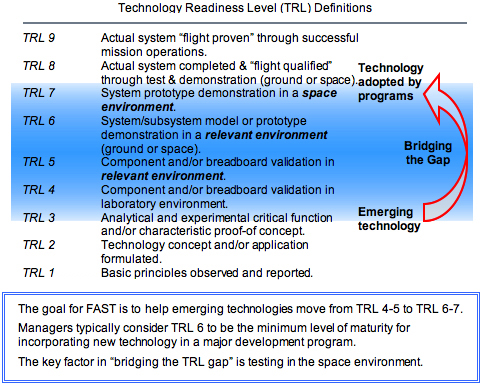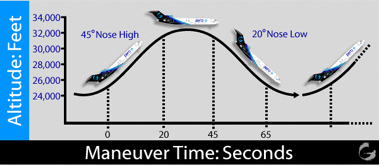| |

|
|
 |
| |
 |
| |
Facilitated Access to the Space Environment for Technology Development and Training (FAST)
LATEST NEWS: A new call for FAST proposals was posted on January 23, 2009. The call was open to all US companies, individuals, research institutions, universities and government agencies. The proposal deadline was March 20, 2009. Selections were to be announced by May 1, 2009. There will be a delay of about one or two weeks in the selection announcement.

FAST provides opportunities for emerging technologies to perform testing in the space environment.
- Technologies that support NASA's missions but are not yet mature enough for adoption into on-going programs (see Technology Maturity below)
- Technologies that might not otherwise be tested due to lack of funding:
- Small businesses and individuals
- Universities and research institutions
- NASA projects in early development
FAST utilizes commercially available flight test capabilities such as the Zero Gravity Corporation aircraft for parabolic flights. The current focus is on testing in micro-gravity, reduced-gravity or variable-gravity conditions on parabolic aircraft flights.
In the future the FAST program expects to provide opportunities to test technology on suborbital and orbital flights when those services are commercially available.

Parabolic Aircraft Flight Testing
NASA has been flying parabolic flights on NASA-owned KC-135 and C-9B aircraft for decades out of Ellington Field under the management of the Johnson Space Center's Reduced Gravity Office. Those flights have made numerous contributions to scientific advancement and technology development. The aircraft can provide about 25 seconds of near-zero-gravity conditions during each parabolic maneuver. It can provide variable gravity levels between zero and one, including 0.16 g for lunar conditions and 0.38 g for Mars conditions. An increased gravity level of up to 1.8 g can be provided for up to one minute.

Microgravity Services Contract
NASA awarded a contract to the Zero Gravity Corporation in January 2008 to provide commercial parabolic aircraft flights to simulate variable gravity environments for research and development work. Each flight includes 40-60 parabolic trajectories. NASA Flight Weeks will generally be conducted out of Ellington Field in Houston, Texas.

+ View Information on 2009 Call for Proposals
The proposal deadline was March 20, 2009. Selections were to be announced by May 1, 2009 but there will be a delay of abut one or two weeks in the announcement. Check here for any further updates.
Flights are scheduled for August 2009
Flights scheduled for August 2009
+ View Information on Previous FAST Flights and Photo Gallery
January 29, 2009: NASA Seeks Technologies For Testing During Reduced Gravity Flights
RELEASE : 09-023
NASA is looking for new technologies that have potential use in future agency projects which could benefit from testing during flights on an airplane that simulates the weightless conditions of space. The technologies may improve air and space vehicle capabilities and support future systems used in space exploration.
+ Read More
|
|

